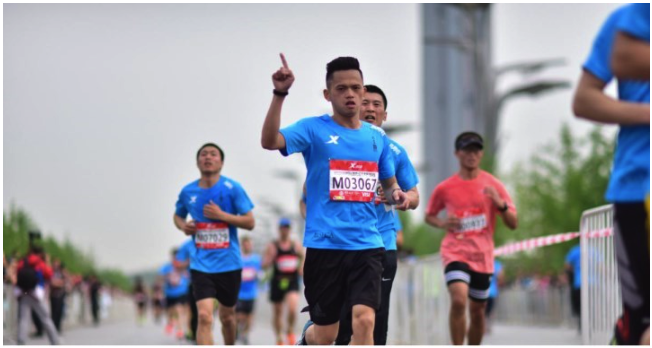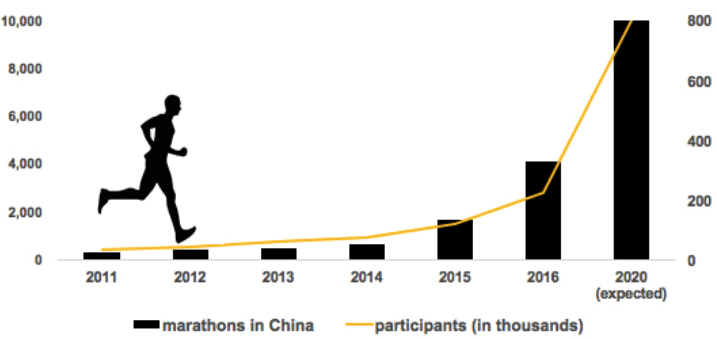
Marathoning hobbyist Du Liyuan nears the finish-line
Courtesy: Du Liyuan
BEIJING – The official time read 1:43:45. Du Liyuan was excited, since he had just achieved his personal best – and done so in the 2017 Beijing Half Marathon.
For the 27-year-old product manager, this was already his fourth marathon of the year. Yet when Du took up running only two years ago, it wasn’t with such competitive aspirations in mind. Instead, it was a quality-of-life decision.
“My work requires me to sit in front of a computer all day long, leaving me exhausted, achy and sore,” he says.
Du isn’t alone, as millions of Chinese have begun doing physical activities regularly, even participating more often in sporting events.
Thanks to an increasing number of Chinese escaping poverty and becoming more health-conscious, people in the country are now able and willing to play sports every day.
Indeed, China, a nation now approaching 1.4 billion people, is witnessing a growing middle class who are willing to spend money on leisure and outdoor activities. A Nielsen report shows, for example, that 36% of core marathoners – those who complete at least four marathons over a three-year period – occupy middle- and senior-management positions, 54% of them own cars, and 42% of them are VIPs at banks.
The government is also promoting sport, and the sports industry as a whole, for its potential as an economic engine.
It’s only since 1984 that China has emerged as a major player at the Olympics, managing to rank fourth in All-Time Medal Table in just a few decades. However, that progress was primarily made due to China’s “single-minded obsession with Olympic gold.” Yet the sports industry itself developed very slowly. That’s now begun to change.
“In 2015, the sports industry in China is worth 1.7 trillion RMB (around 260 billion USD), accounting for 0.8% of the GDP,” said Li Yingchuan, Assistant Director of the General Administration of Sport of China (GASC).
In comparison, the sports market in the same year contributed to 2.1% of GDP in average worldwide. Specifically, the figures for Japan, America, France and Korea are 2.5%, 2.9%, 2.9% and 3.0% respectively.
After all, running marathons, for example, is not as cheap as many might think. The report reveals that core runners spend an average of 4,594 yuan (US$670) per year.
The government, therefore, wants to tap into the economic potential of this emerging industry.
The State Council in 2014 issued Suggestions on promoting sports industry and boosting sports consumption. In the Suggestions it is estimated that in 2025, the industry in China will be worth five trillion RMB, and will become “a primary driving force behind sustainable socio-economic development.”
Later, GASC issued development plans for winter sports, aquatic sports, air sports, outdoor sports and self-driving travelling.
The industry since then grew rapidly; the booming number of marathons is a prime example, according to Feng Jianzhong, Vice Director of GASC.
The capital, Beijing, held China’s first registered marathon, in 1981, where only 82 runners participating. In 2010, there were 13 marathons held. Six years later, China had 328 marathons where about 2,800,000 runners participated – a 700% increase compared to the figure for 2011.
Indeed, demand is exploding: it is anticipated that in 2020, over 800 marathons will be held, with more than 10 million runners participating.
“Marathon races are the new blue sea of the sports industry in China,” says Du Zhaocai, director of the Administration Center of Track and Field Sports in China.

Growing number of marathons in China
Data drawn from anhuinews.com, sohu.com, and other sources; Graphic by Hongtao Hao
In terms of sports industry, central and local governments are only the director; the real actors are companies.
The financial report of Wisdom Sports Group, the largest of its kind around the world (in terms of the number of marathons organized), reveals that its gross profit in the first half year of 2016 reaches 106 million yuan (US$15.6 million), a 58% YoY increase.
In 2015, Tencent, an Internet company with over 800 million active daily users, obtained the right to stream for five years NBA live games and content — a $700 million deal.
But the real heavyweight might be Wanda Sports.
“Wanda Sports is now the world’s largest sports company,” Wang Jianlin, chairman of Wanda Group and also the richest man in China, said.
Indeed, the impact of this Chinese company is felt all over the world: in January 2015, Wang bought 20% stake in Atletico Madrid, a Spanish football club, for $52 million; in August of that year, Wanda Group bought World Triathlon Corporation for $650 million.
Only investments, however, are not enough to boost the sports industry in China. If the industry is to become stronger in general, a culture needs to be cultivated.
Take marathon as an example.
“The services we provide are no different than those in Boston, London and Tokyo. The biggest difference lies in the marathon culture, public participation and the overall atmosphere.” An employee in Beijing Marathon who declines to give his name commented.
But with the number of people taking part in marathon grows exponentially, hopefully, the culture will also mature.
While the industry growing fast, so are Du Liyuan’s dreams.
His goal for the rest of 2017 is to complete a marathon within 3 hours and 30 minutes.
“And my life goal is to run all of the six most famous marathons in the world,” he says, full of hope and confidence.